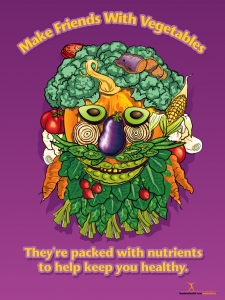Kale seems to be one of those foods that you either like or you don’t. For my husband, it’s a definite dislike. According to him, one of the only good things about his recent heart attack is that he isn’t allowed to eat kale.
OK…perhaps this is “selective hearing” on his part. All he heard was don’t eat kale or other leafy greens because it will interfere with your drugs. Yes, he is now taking Warfarin (also known as Coumadin) prescribed to prevent blood clots due to his heart disease. He also has to go to his doctor’s office frequently to have the Warfarin levels in his blood tested (INR). In the beginning these levels varied greatly and the he wanted to get it balanced, so he avoided kale (this was not a big sacrifice) along with all other green vegetables.
Why the avoidance? Vitamin K. This vitamin plays an important role in blood coagulation—which when you are on Warfarin you don’t want to happen. It is found mainly in green vegetables. What foods are the highest in Vitamin K? Kale, spinach, collard greens, mustard greens and cooked broccoli.
The doctors and the folks at cardiac rehab were quick to tell him, “no, don’t avoid these vegetables completely—just balance them out”. The key is to eat the same amounts of Vitamin K foods every week. Yes, it does affect the working of the drugs, but the levels can be adjusted for the amounts of Vitamin K foods you eat on a regular basis—the key word here is consistent.
So did he do this? No. He avoided all vegetables that were even close to green—including iceberg lettuce. Why, I don’t know, perhaps it is one way he can to be “in control” and also to make sure that the levels of the drug in his system were constant. I can understand this.
I bet he’s not the only heart patient that has done this.
But this avoidance of vitamin K foods puts a real crimp in our menu planning. He’s now trying to eat more healthful, follow the DASH (Dietary Approach to Stop Hypertension) diet and lose some weight. We all know one of the most important things we all should be doing is eating more vegetables. Hard to do when you’ve taken many out of the running.
This goes counter to everything I’m used to regarding shopping and eating. No broccoli, no salads, no spinach…no kale. We’ve been eating lots of tomatoes, celery, winter squash, zucchini, yellow squash, spaghetti squash and have even expanded to pumpkin and eggplant. We’re always teaching variety in vegetables…this isn’t the way to go.
Now that we’re almost five months into this adventure he has begin to add these vegetables back in to his (our) diet. I’m glad. But I’m not sure I’ll ever get kale onto his plate.
Cheryle Jones Syracuse, MS
Professor Emeritus, The Ohio State University
Here are tips for people who are timid about eating and trying new vegetables.
- Focus on the presentation. Chances are, if the vegetables are fresh, cut in small pieces, and served with a sauce, people will try them just because they are sitting in front of them. One favorite idea is to place vegetable sticks in a glass with a little light Ranch Dressing on the bottom.
- Carrots, yams, and winter squash are sweet and they have a bright orange color so they are a great place to start.
- Cook items perfectly so they are not overcooked or discolored will help. Steam items for 2 minutes to start and then check doneness.
- Focus on a favorite dressing or sauce.
- Grilling vegetables can be a fun and delicious way to get people to eat them.
- Chopping vegetables finely and adding them to salads and pasta sauce can bring success.
- Chili is also a great place to add more veggies.
Check out our Fruit and Vegetable Promotion Items:
